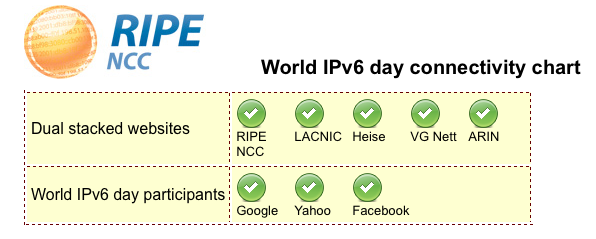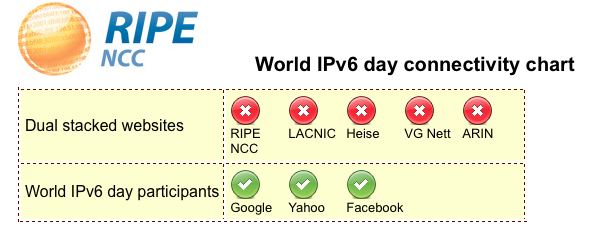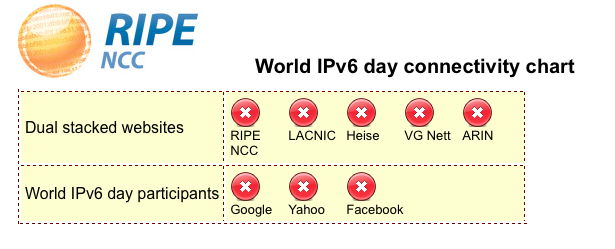As announced earlier, the RIPE NCC is going to measure World IPv6 Day. This article details the measurements we intend to do.
Editors note: Please see the first measurements now on http://v6day.ripe.net/
On 8 June 2011, a large group of content providers is going to move from serving content single-stacked over IPv4, to serving content dual-stacked over both IPv4 and IPv6. This event, initiated by Google IPv6 engineer Lorenzo Colitti, is called World IPv6 Day , and its purpose is to do a test-flight of dual-stacking content. This is important, since with the near exhaustion of the free IPv4 address pool, the Internet needs services that are accessible over IPv6.
The potential problem the content providers that participate want to overcome is 'dual-stack client loss' : A very small fraction of end-users that will not be able to reach a dual-stacked web site. This can be caused by the following: the application and/or the operating system (OS) the end-user is using picks a protocol family (IPv4 or IPv6) that doesn't provide connectivity to the web site, for that particular end-user.
In addition to having helped out our colleagues at APNIC with creating a javascript library that integrates IPv6 measurement into Google Analytics , we plan to do three types of measurements:
- A connectivity-test to World IPv6 day participants - the IPv6 Eye Chart
- Connectivity and performance test to World IPv6 day participants from TTM (our Test Traffic Measurements infrastructure)
- Relative performance of 6to4 before and during World IPv6 day
The rest of this article will describe these measurements in some more detail.
1. The IPv6 Eye Chart
The IPv6 eye chart is a test of connectivity to World IPv6 Day participants (i.e. the content providers that will dual-stack for a day) and sites that are already dual-stacked. It is a single web page that, when visited, tests the connectivity of the visitor to lots of websites. This can be used to find out if there are problems accessing these websites, both before and during World IPv6 day.
The following image shows the results of this test for a user that doesn't have any problems connecting to any of the sites:

Note that this is a prototype, the list of World IPv6 Day participants is currently over 150 entries! We are also actively looking for content providers that are already dual-stacked and that want to be included in the test. If you want to participate, please email us at labs@ripe.net , and provide us with a link to an image we can fetch from your dual-stacked website.
The following image shows what - a hopefully minimal fraction of - users that have problems connecting to dual-stack websites, will see before World IPv6 Day:

These users are urged to fix their connectivity, because otherwise on World IPv6 day their connectivity is going to look like this:
 The eye chart page is going to include more explanation, and links to information on debugging and fixing connectivity problems related to connecting to dual-stacked websites, including Jason Fesler's excellent test-ipv6.com and Microsoft's Knowlege Base article on how to disable tunnel IPv6 interfaces. As the earlier RIPE Labs articles 6to4 - How Bad is it Really? and 6to4 - Why is it so Bad? describe, tunneled IPv6 traffic is a large contributor to broken IPv6 connectivity. So, disabling tunneled IPv6 interfaces is a logical step when you detect broken connectivity to dual-stacked websites.
The eye chart page is going to include more explanation, and links to information on debugging and fixing connectivity problems related to connecting to dual-stacked websites, including Jason Fesler's excellent test-ipv6.com and Microsoft's Knowlege Base article on how to disable tunnel IPv6 interfaces. As the earlier RIPE Labs articles 6to4 - How Bad is it Really? and 6to4 - Why is it so Bad? describe, tunneled IPv6 traffic is a large contributor to broken IPv6 connectivity. So, disabling tunneled IPv6 interfaces is a logical step when you detect broken connectivity to dual-stacked websites.
The IPv6 Eye Chart is now available online.
2. TTM Connectivity Testing
The Test Traffic Measurement service (TTM) is a collection of over 100 hosts that perform precision Internet measurements, over 40 of these hosts are dual-stacked. For World IPv6 day we plan several checks to a selection of World IPv6 Day participants:
- Are World IPv6 Day participants announcing A and AAAA records?
- Are World IPv6 Day participants pingable over IPv4 and IPv6 (ping/ping6)?
- Can we fetch content from World IPv6 Day participants over HTTP?
- What's the forward path over IPv4 and IPv6 to the World IPv6 Day participant (traceroute/traceroute6)?
We are working to see if we can augment our measurements from TTM with other measurement infrastructures, notably CAIDA's Archipelago infrastructure. If you are running a measurement infrastructure and are willing to participate as well, please contact us at labs@ripe.net .
3. 6to4 Performance
Some people are concerned that on World IPv6 Day 6to4 relays could become overloaded. Luckily most modern OSes will not attempt to use 6to4 when native IPv4 is available, but the remaining 6to4 traffic might still cause problems. We are working with a team of students from the University of Applied Sciences, Amsterdam to compare the performance of 6to4 to native IPv6, before and on World IPv6 Day.
We run this from a measurement host that does 2 ping6 measurements to a single target at the same time: One is using it's native IPv6 source address, the other one is using a 6to4 IPv6 address, for which the return traffic will end up on our measurement host as well, due to the fact that the IPv4 address of our measurement host is encoded in the 6to4 IPv6 address. This is visually explained in the figure below:

By comparing the differences both in RTT and packet loss for the native IPv6 and the 6to4 IPv6 test to a single destination, we get a baseline of 6to4 relay behaviour. This is either going to change or stay the same on World IPv6 day, which is what we intend to measure.
If you run a 6to4 relay and want to be included in these tests, please let us know at labs@ripe.net . The information we need from you is the location of the 6to4 relay (what AS, geolocation), and we would need a ping6able host for which traffic destined for 2002::/16 will end up at your specific relay.
Conclusion & Feedback
In this article we described our plans for doing measurements of World IPv6 Day. If you want to participate in specific measurements, please write us at labs@ripe.net . For general comments on this article, please don't hesitate to leave your comments below.
We will keep you updated on our progress and results on RIPE Labs, so expect more here the upcoming weeks! For once, I hope measuring this event is going to be extremely boring, which means World IPv6 Day will be a big success.





Comments 6
The comments section is closed for articles published more than a year ago. If you'd like to inform us of any issues, please contact us.
Anonymous •
I believe Jason Fesler's page is test-ipv6.com, not ipv6-test.com as indicated in the article.<br /><br />Tore
Anonymous •
yes, my bad. I fixed that.
Anonymous •
You give me too much credit. :-) I didn't "initiate World IPv6 Day", it was a collaborative effort.
Anonymous •
credit where credit is due :)<br />If you have a better characterisation, please let me know and I'll change it.
Anonymous •
I'm using the Javascript code provided by APNICs for adding IPv6 probing to Google Analytics, but I'm worried that the high RTTs to labs.apnic.net (around 330-340ms from our Swiss network, with IPv6 consistently ~10ms LESS btw) might affect the measurement results when people leave pages after a few seconds. Wouldn't it be great if there were alternative probe servers for web servers far away from Australia? For example RIPE NCC could host some - if not I'm sure there would be other volunteers, provided APNIC would agree to distribute the measurement system.
Anonymous •
Hi Simon,<br /><br />I'm intimately familiar with the APNIC javascript code, since I wrote a big part of it. ;)<br />We could certainly host a parallel infrastructure, if there is enough interest. So if others are interested in this too, please respond to this thread.<br /><br />In fact we have our 'version 1.0' of this type of measurement still up at:<br /><a href="http://albatross.ripe.net/v6-clientresolver/" rel="nofollow">http://albatross.ripe.net/v6-clientresolver/</a><br />where we measure a couple of sites. We also still take people who want to participate there.